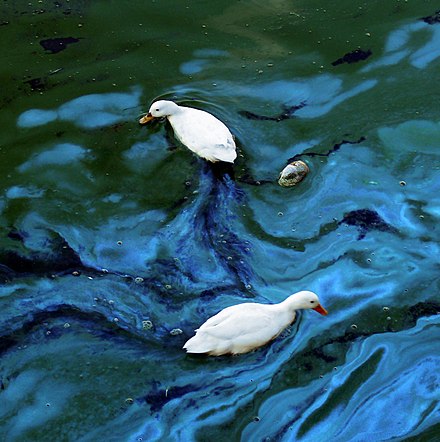Algal bloom
Algal bloom
Algal bloom is a phenomenon where certain genera of algae (notably Alexandrium and Karenia) or cyanobacteria ("blue-green algae") reproduce explosively. When the species involved produce toxins, which often is the case, this makes the water unusable and possibly dangerous.
Understand
 Although most such "blooming" species are microscopic, the concentrations are big enough to change the colour of the water and often give the impression of flakes. For cyanobacteria the result is green, for some algae red ("red tides"). It has been argued that one of the plagues described in the Bible where the Nile supposedly turned into blood, refers to an algal bloom, if the event is historic at all.
Although most such "blooming" species are microscopic, the concentrations are big enough to change the colour of the water and often give the impression of flakes. For cyanobacteria the result is green, for some algae red ("red tides"). It has been argued that one of the plagues described in the Bible where the Nile supposedly turned into blood, refers to an algal bloom, if the event is historic at all.
The bloom is a result of favourable conditions, such as large amounts of nutrients and suitable weather. It is not related to flowers, the species involved reproduce in other ways.
The involved classes of organisms are not necessarily harmful in general. Indeed, cyanobacteria are believed to have made the earth inhabitable for species breathing oxygen, and the chloroplasts in algae and plants (allowing them to use sunlight to produce nutrients) may have originated from a symbiotic relation with cyanobacteria.
Also pollen can accumulate in large quantities, and can then look quite similar to algal bloom, but is not harmful.
Destinations
- Great Salt Lake, Utah, 41.106628°, -112.426309°. A railroad line – the Lucin Cutoff – runs across the lake, crossing the southern end of Promontory Peninsula. The mostly solid causeway supporting the railway divides the lake into three portions: the northeast arm, northwest arm, and southern. This causeway obstructs the normal mixing of the waters of the lake because there are only three 100-foot (30 m) breaches. Because no rivers, except a few minor streams, flow directly into the northwest arm, Gunnison Bay, it is now substantially saltier than the rest of the lake. This saltier environment promotes different types of algae than those growing in the southern part of the lake, leading to a marked color difference on the two sides of the causeway. On December 1, 2016, the causeway was open under a newly constructed 180-foot-long (55 m) bridge that allowed water to flow from the southern arm of the lake into northwest arm. At the time of opening of causeway the northwest arm was nearly three feet lower than the southern arm. As of April 29, 2017, the levels of both arms of the lake have risen due to spring runoff, and the northwestern arm is within one foot of the southern arm. 2018-06-27
- La Macarena, 2.185877°, -73.787268°. Colombian destination known for its red blooming river, the Liquid Rainbow. While this is not algal bloom per se, as it is caused by small plants, it looks close enough. 2018-06-27
- Western Lake Erie, 42.2°, -81.2°. The southwest coast of Lake Erie near Toledo is frequently the site of massive algal blooms. Rarely these blooms will reach Cleveland. 2019-03-04
Stay safe

Some organisms consuming the blooming species, such as shellfish, may accumulate the toxins and thus themselves become poisonous.
In many places bathing in algae infected bodies of water is prohibited and you should heed the advice of local authorities, even though they might err on the side of caution in some places (and in others checks are done too seldom to be of any use).